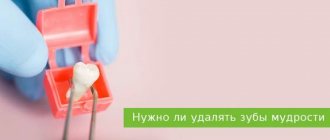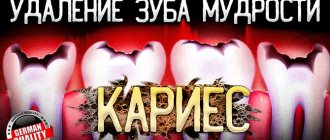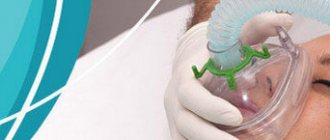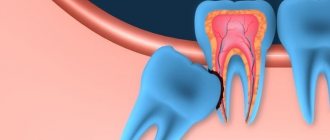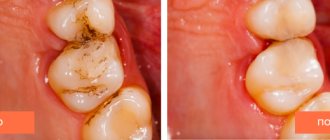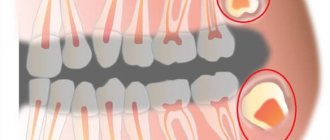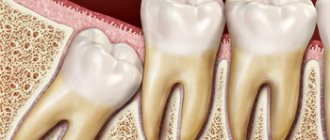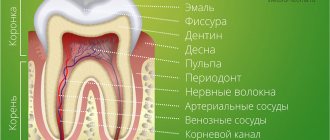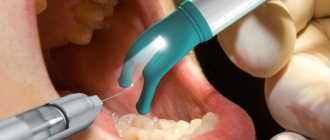Posted by Marbery Gedrean | Checked by: Shteba Victoria Petrovna | Last revised: October 18, 2022.
Most parents are very concerned about how teething (and gums) affects their babies in everyday life. Although we cannot fully predict exactly how each baby will react to their first tooth. However, we can learn about teething symptoms and how to calm your baby during this difficult time. Overall, the more we know about teething, the better we can help our babies survive it. Let's figure it out.
Timing of teething
One of the most common questions parents ask is: “How long does teething take for babies?” It is useful to know both the time frame for the appearance of the first tooth and the time frame for the eruption of all teeth. In general, teething is an ongoing process that occurs between 6 and 24 months of age. Although your baby has twenty baby teeth that will appear over the course of two years, teething fortunately only causes pain and irritation at the time the tooth is about to break through the gum. It is not known exactly how long it will take for a tooth to fully erupt, but on average experts say it can erupt within 1-7 days per tooth. However, teething symptoms usually only last a couple of days, so if your baby experiences discomfort for an extended period of time, it's safe to assume it's not teething.
Maybe they don't exist?
All people have the beginnings of figure eights. But this does not mean at all that they will break through to the surface of the gums and there will be a full set of 32 permanent teeth on the dentition.
The structure of the modern human jaw makes the eruption of wisdom teeth increasingly difficult. Sometimes they simply do not have enough space on the jawbone, and they remain in the embryonic stage.
But there is also such a thing as an impacted wisdom tooth. This is a full-fledged molar, but it is completely or partially hidden in the jaw bone or gum.
Such teeth, despite the fact that they never erupted, are usually of completely normal size. In addition, they can get sick just like everyone else.
Read also: Why you can’t rinse your mouth after tooth extraction
The growth of wisdom teeth is very individual. Both the time of eruption of the “eights” and their location on the human jaw differ.
Timeline of teething
Most babies' first teeth emerge between 6 and 7 months of age, but this may happen earlier or later. In general, your baby's teeth will most likely appear in the following timeline windows:
6-7 months
During this time, the process of erupting the first teeth begins. The first teeth to emerge are usually the lower central incisors, which are the two middle teeth at the bottom. Children at this age become more active. They begin to grab and pull objects towards themselves, transfer objects from one hand to another, and may even begin to crawl. It is important to keep an eye on small objects within your baby's reach as he will want to put everything in his mouth during teething!
From 8 to 13 months
Between 8 and 12 months, your baby's upper central incisors will emerge. Additionally, sometime between 9 and 13 months, they will have upper and lower teeth next to their upper central incisors (called lower and upper lateral incisors). In addition to teething, it is important to understand that other important gross motor milestones are reached during this developmental window. Most babies are able to sit up, stand up without assistance, take their first steps, pick up and throw objects, roll a ball, and grasp objects.
From 13 to 20 months
Typically, between 13 and 16 months, your baby's first molars will appear on the bottom and top at about the same time. Soon after this, their canines will appear on both the top and bottom rows, around 16 to 20 months.
From 20 to 30 months
At the final stage of teething, the baby's back teeth or second molars appear in the bottom row. Although most teething symptoms appear the same in both babies and toddlers, there are some differences as your baby gets older. First of all, your baby can now tell you about his discomfort and pain, unlike non-verbal babies. On the other hand, many babies will not show any signs of discomfort and will not complain at all about pain when moving their molars. For other babies, the pain may be significantly worse because their first molars are larger than their other molars. They may even complain of headaches or jaw pain!
When do wisdom teeth start to grow?
The period when wisdom teeth can erupt ranges around 20 years.
They usually appear already at a conscious age in an adult. Some people may have all 4 molars at the age of 20, while some people still don’t have a single molar at the age of forty. The average age when figure eights begin to appear is 17-25 years old. Data from X-ray studies have shown that the formation of the rudiments of wisdom teeth in the oral cavity occurs as early as the age of seven. The process of forming their roots occurs during adolescence - 14-15 years. Their eruption, and how long it will last, is influenced by many factors, including:
- heredity;
- general condition of the body;
- nuances of the individual structure and structure of the jaws.
Do baby teeth need to be treated?
Caries is quite common in children at a very young age. To prevent caries, parents should pay special attention to their baby’s oral hygiene.
You need to treat caries in baby teeth! If caries is not treated, it can cause serious complications:
- early (unnatural) removal can lead to incorrect formation of a permanent tooth or to disruption of bite formation;
- violation of chewing function, which leads to the development of gastrointestinal pathologies;
- the development of pulpitis or periodontitis, which can provoke purulent inflammatory processes.
The permanent crown did not appear
Long-term absence of permanent teeth can be caused by two reasons:
- Retention. It is characterized by slow eruption of the crown due to prolonged development of the rudiment or its incorrect position, for example, deep burial.
Retention can be either complete or partial. Partial is characterized by incomplete eruption, when the coronal part only appears slightly in the gum and stops growing.
These pathologies can be caused by certain factors:
Stimulation
In case of late tooth eruption, specialists prescribe special stimulating therapy. Standard stimulation therapy includes the following methods:
- Applying applications. To do this, use a ready-made 0.05% solution of humic acid obtained by isolating low-mineralized type sulfide silt mud.
The solution is prepared on the basis of isotonic sodium chloride. A tampon is soaked in the drug and applied to problem areas for an average of 5 minutes. The procedure is carried out for 15 days and no more.
This drug has a powerful biostimulating effect by improving tissue respiration, normalizing metabolic processes and sedimentation of minerals necessary for crown development.
In addition, the product leads to slight loosening of the bone area in the area where the rudiment is located, which facilitates its formation and eruption. Irritating removable dentures. It is a structure that looks like a bridge. But, unlike it, in an irritating prosthesis the main supporting part is located not on the adjacent teeth, but on the gum.
Due to constant pressure on the area of the jaw with an impacted rudiment, trophic processes are improved and its growth is stimulated. The period of wearing the prosthesis will depend on each specific case. Gum tissue massage. Aimed at regulating metabolic processes and saturating tissues with minerals. As a rule, massage is done 1-2 times a day until a positive result appears or for at least 8 months.
A set of exercises is selected by the doctor depending on the patient’s age and the area of the tooth. Physiotherapeutic procedures. The most effective in this case was electrophoresis performed using adrenaline or lidase. Both drugs have the same pronounced stimulating effect, but their therapeutic effects are completely different.
Read also: Should I remove wisdom teeth or not?
Adrenaline is a hormonal drug whose action is aimed at stimulating the natural process of teething.
Unlike lidase, it gives a faster and more predictable result, but can cause a disorder in the hormonal balance of the child’s body, which will entail negative changes in terms of general health.
The main action of lidase is aimed at loosening the bone area in the area of the bud, which facilitates the process of its eruption.
This drug also has its disadvantages: such exposure can lead to disruption of the mineral balance of the dental tissue of the developing tooth and adjacent crowns. The drug Honsurid. Aimed at restoring the functions of the embryo and improving metabolism in bone and cartilage tissues. The drug is used externally, diluting it with novocaine or sodium chloride.
For a stimulating effect, the drug is used to treat the mucous membrane in the area of the supposed root of the problem area. The procedure can be carried out once every 2 days for 10 days.
In some cases, the course can be extended to 1 month.
Survey
Despite the existence of average periods for the eruption of permanent teeth, they are individual for each child.
A discrepancy of one or two years is quite acceptable.
But if eruption has not begun even 4 years after the loss of milk crowns, then this is a direct indication for a detailed examination. The following methods are used for this:
- visual examination – allows you to determine the general condition of the oral cavity;
- palpation and instrumental examination will show the degree of density of the gum tissue;
- intraoral targeted radiography. Performed to obtain accurate data on the position of the bud;
- orthopantomography – helps to see the condition of the embryo and its tissues;
- CT scan allows layer-by-layer examination of the tissues of the bud and the surrounding bone.
Diseases
During the examination, the following diseases are most often detected:
- rickets or rickets-like condition. It occurs due to a constant lack of bone-forming minerals due to a pathological condition. To resolve the problem, it is necessary to undergo long-term treatment with the inclusion of drugs with a high content of minerals and vitamins;
- pathologies of the endocrine system. Most often, the cause is hypothyroidism suffered in the first year of a child’s life. Treatment requires the use of hormonal drugs, both local and general;
- infectious diseases of a chronic type , for example, tonsillitis. As a rule, in the presence of such pathologies, it is necessary to carry out complex treatment aimed both at eliminating the disease itself and at increasing the immune functions of the body;
- acute respiratory diseases , which occurred at the beginning of the growth of permanent crowns. A problem of this nature should be addressed by a dentist together with a therapist.
Prevention of malocclusion
The timeliness of replacing baby teeth with permanent ones is important, since the correct development of the child’s bite depends on this. To ensure the normal formation of the dentition, it is necessary to follow a number of important rules:
- parents need to monitor the quality of their child’s oral hygiene , since children’s enamel is most susceptible to caries, and this can provoke premature loss of the crown;
- The child's diet should be as balanced as possible . It should not contain large quantities of foods containing fast carbohydrates. The menu should include foods rich in microelements and vitamins ;
- You should not avoid routine visits to the dentist. This will help prevent the development of dental pathologies and reduce the likelihood of retention;
- to take the child to an orthodontist or dental therapist as soon as possible .
Even more information about baby teeth in the video from Dr. Komarovsky:
What to do?
If a breast crown falls out, there is no need to immediately run to the dentist. In order to reduce the risk of infection in the wound and eliminate negative consequences, the following steps must be taken:
- Immediately after the prolapse, it is necessary to form a tampon from cotton wool or medical gauze and place it on top of the hole. The child should lightly press it with his teeth and fix it in this position for 15 minutes .
During this period, a blood clot is formed in the socket cavity, which performs protective functions. As the hole becomes overgrown, it will disintegrate on its own.
- During the day, you can irrigate the wound with antiseptic drugs .
- In order to relieve swelling, it is recommended to take baths with a solution prepared from ½ teaspoon of salt .
- Before eating, to minimize pain, it is recommended to treat the edges of the wound with lidocaine-based dental gel . For children, a special drug called calgel .
- You should not give your child food within 2 hours after a tooth falls out.
- On the first day, you should avoid eating foods at borderline temperatures, as well as foods high in acids.
Change process
The jaw of a child under 5 years of age is distinguished by a small jaw arch , which is not capable of accommodating the entire set of full-fledged molars. Therefore, it is first filled with temporary crowns, which are characterized by their small size and thin, shortened root.
They prepare the gums for secondary eruption and determine the location in the jaw arch for permanent teeth. During the process of replacement, the root of temporary teeth gradually dissolves and the crown part is only slightly retained by the gum tissue.
The permanent tooth, developing in place of the milk root, eventually pushes out the temporary crown .
The shift period begins at 5–6 years of age and ends at approximately 14 years of age.
The change occurs in the same order in which the eruption took place. Depending on the individual developmental characteristics of the child’s body, the timing of the loss of each crown may vary. The divergence period ranges from several months to 2 years .
Teething symptoms
The appearance of eights occurs differently for everyone. In some cases, the eruption of wisdom teeth can go almost unnoticed, in others it can cause pain and a number of other unpleasant symptoms:
- Sore gums. It appears due to the fact that the sharp parts of the molar exert a certain pressure on the oral mucosa, injure the gums, and compression of the bone tissue occurs. Usually, in the absence of complications, the pain is mild and tolerable.
- Severe aching pain. This type of pain indicates the development of an inflammatory process, which may be caused by improper location or direction of molar growth.
- Swelling of the gums and cheeks. This is a signal about the possible presence of pericoronitis - the overhang of the hood over the eruption area.
- Increased body temperature. The main sign of the onset of inflammation. The body's defense mechanisms are activated. The temperature can remain at 37-38 degrees for 2-3 days.
- Problems opening and closing the mouth. Occurs when inflammation affects the masticatory muscles.
- It hurts to swallow. This symptom appears in the presence of a purulent abscess or when inflammation has spread to the roots of the nerves passing through the soft tissues.
In some cases, other symptoms may also be present. For example, slight chills, enlarged lymph nodes located under the jaw, weakness and malaise, slight itching in the eruption area.
A baby tooth falls out and a new one doesn’t grow - why?
Sometimes the development of permanent teeth is hindered by the following reasons:
- If the baby has suffered an infectious disease. The emergence of health problems means a lot of stress and energy consumption. A set of resources necessary for the construction and provision of minerals to a molar. He is thrown to fight the disease. It is common for experienced pediatricians to warn about this. They prescribe vitamins for preventive purposes.
- Not enough calcium. The cause of such deficiency is not necessarily associated with pathological changes and diseases. There are cases of congenital manifestation, especially when the child is born prematurely. Poor nutrition may also be a cause. Because of this, the baby’s hair grows poorly, the skin turns pale, the nails become soft and brittle, and it is necessary to urgently adjust the diet. Among the existing tips that traditional medicine gives is the use of eggshell powder. However, you must first consult with a nutritionist.
- Due to caries, the base of an old tooth or a future permanent one can be affected. Then tooth growth will be delayed. Or the tooth will grow in the wrong direction. Vigilance is important so that malocclusion does not develop and it is clear how long it will take for the tooth to grow after the milk one.
- Mechanical injuries due to a fall and a strong blow to the jaw. Then the surface of the buds can be “driven” into the gum and periosteum. Only surgical intervention can correct the situation. The health of the tooth depends on the speed of its use if baby teeth have fallen out and permanent teeth do not grow.
What is the order in which teeth appear?
Most babies begin teething at 6 months. The eruption period lasts approximately three months. The lateral incisors appear by 10-12 months. As babies approach one year of age, 8 teeth erupt (plus or minus four teeth is not a deviation). If by this time not a single tooth has appeared, you need to consult a specialist and take a panoramic photo of the jaws.
The first molars appear at 12-15 months. Fangs begin to erupt after 18 months. As a rule, this is the most painful stage, since in the area where these teeth are located there is a nerve connected to the upper part of the face.
At 2 years of age, each jaw will have approximately 8 teeth. A complete set of baby teeth (20 pieces) appears in a child by the age of three. Baby teeth begin to change to molars at 7-9 years of age.
Removing figure eights before installing braces
Most often, the orthodontist comes to the conclusion that wisdom teeth must be removed before starting orthodontic treatment. This can only be avoided in some cases, for example, if the molars have fully erupted and are in the correct position relative to other teeth in the oral cavity. Semi-erupted and hidden units in the gum must be removed surgically.
It is recommended to remove impacted eights before treatment, but this can be done after. It is important not to delay and carry out the operation in the first few months after fixing the orthodontic structure on the teeth.
Removal is necessary due to the fact that when wisdom teeth erupt, all other units inevitably begin to move forward. This can lead to the fact that the result obtained during the long-term work of the orthodontist will be lost. Crowding and crookedness may appear, and the process of correcting the bite will have to start all over again.
Indications
As mentioned earlier, wisdom teeth most often have to be removed. This must be done if there is not enough space for the remaining teeth in the row. As a result of the removal, sufficient space will be freed up for the remaining teeth to take the correct position without anything interfering with them. In addition, the absence of third molars can significantly speed up the treatment process, because the braces will not be forced to withstand strong resistance from the jaw tissue during their movement.
Many parents worry that there will be a gap or a wide gap in place of the wisdom tooth. However, dentists say the opposite: in just a few months, the bracket system will make the row even and dense, without gaps.
From the time the surgeon performs the surgery to remove wisdom teeth, at least several weeks must pass before the start of orthodontic treatment. This is necessary for partial healing of the wound and protection against infection.
It is worth knowing that each clinical case is strictly individual. Only after a thorough examination and with all the necessary photographs of the jaw, the doctor can make a final decision. It is possible that removing the buds may not be necessary at all.
As a rule, to obtain comprehensive information, it is sufficient to conduct a panoramic examination and obtain an image of the entire jaw. In some cases, a CT scan may be prescribed. An experienced orthodontist always works in tandem with a surgeon; together they will definitely find the optimal solution to the current situation.
It is very important to contact only trusted dental clinics, where experienced specialists work. This will allow you to be confident in an excellent treatment result.
previous post
Surgical correction of bite cost
next entry
In what sequence are they replaced with permanent ones?
The period of change of bite begins at 6 years of age and ends at 13–14 years of age. The interval can vary within a radius of 2 years. There is a certain order of drops:
- The first to fall out are the lower primary incisors, which were the first to erupt;
- Then - the upper front ones;
- Side lower front.
The situation can vary depending on factors when there is not enough space for neighboring teeth and they push others. Changing the sequence should be a signal to visit the dentist.
Read also: What to drink if your tooth hurts
Timing for replacing baby teeth with molars
Very often there are complications during the period of mixed dentition, when the first one stands motionless in place, but is pushed out by the permanent tooth that grows from above. Parents should take the child to the dentist to resolve the situation. If the tooth itself does not fall out, it needs to be pulled out . So that the new one is even.
We need to help children brush their teeth, because they cannot yet perform precise movements. The arsenal should include:
The child needs to be instilled with dental culture so that he is not afraid to take care of his oral cavity. When a tooth falls out, the wound should not be smeared or rinsed, so that a plug does not fall out, which forms in its place and closes the path for the entry of microbes.
Their change, as a rule, occurs unnoticed, asymptomatically, painlessly. Sometimes the gums can become inflamed. In this case, you will need to consult a doctor, and it is necessary to treat the disease as problems arise. This will directly impact the oral health of long-term residents.
The shift time is constant for each person and is set individually. But if there is a significant slowdown, it is important to consult a doctor. He will promptly help solve the problem. During the period of occlusion change, the diet should contain hard foods.
It is necessary to load the jaw so that all physiological processes occur harmoniously. If parents see problems with uneven growth, it is important to get a consultation in a timely manner and consult with an orthodontist.
You need to load your jaw
How painful is wisdom teeth removal?
The question of the pain of wisdom tooth removal arises in all patients who need such an operation. The removal procedure is carried out under local anesthesia (various painkillers are used - ultracaine, septanest, ubistezin and others). The complexity of removal and pain depend on many factors: the structural features of the root system, the location of the tooth, the presence of complications in the form of cysts, suppuration and others, as well as the pain sensitivity threshold of a particular person.
What to do if your wisdom tooth hurts during pregnancy
Unfortunately, any pregnant woman may experience various unpleasant conditions and diseases. As with any other period, the eruption of wisdom teeth can occur during pregnancy and this can be a cause for concern. Many people wonder whether wisdom teeth can be treated during this period and how to deal with pain relief during this period. Gynecologists advise treating teeth (including “eights”) after the 16th week of pregnancy. It is during this period that all systems and organs of the fetus are already formed, so the use of painkillers will not negatively affect the child.
Folk remedies used to treat wisdom teeth
The following traditional medicine recipes will help reduce signs of gum inflammation and make teething less painful:
- The most common and simple method is rinsing the mouth with solutions of oak bark, sage, chamomile or soda solution.
- The inflamed gum above the figure eight can be lubricated with sea buckthorn oil.
- Rinsing the mouth with a decoction of chicory root. It has analgesic and anti-inflammatory effects. Add 1 tablespoon of chopped chicory root to 250 ml of boiling water and boil it all for 5 minutes. Then the broth is infused for 1 hour, after which you can use it to rinse the mouth 3-4 times a day.
- A saline solution with camphor and ammonia will have an analgesic effect. To prepare it, add 1 tablespoon of sea or table salt, 100 g of 10% ammonia and 10 g of camphor alcohol to 1 liter of cool boiled water. Shake everything well, then apply a cotton ball dipped in it to the teething site for 10-15 minutes. The procedure can be repeated several times a day.
Do not forget that any traditional medicine methods can only provide short-term relief, so do not hesitate to visit a dentist. Only a specialist will be able to answer you whether the wisdom tooth is growing correctly or not and whether there is a need for its removal.
